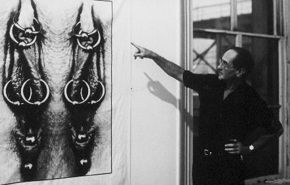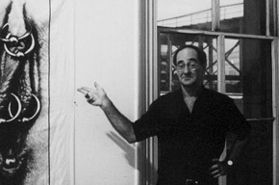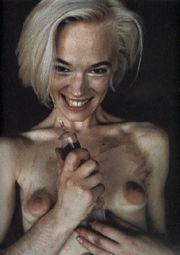
COPYRIGHT © 1997 MARK KRAMER AND BME
MY DINNER WITH GATEWOOD
-- Mark Kramer

An unblinking act of voyeurism more prolonged than Charles Gatewood's 30-year photographic career simply does not exist in art's visual lexicon.
In recognition of this continuing quest to bring once-unexposed categories of arousal into the objectifying light of photo-journalistic scrutiny, Charles Gatewood was recently feted at a dinner given by Brooklyn's Williamsburg Art and Historical Center--site of The Body and Beyond, a major Gatewood retrospective timed to coincide with release of his latest book, True Blood.
The Williamsburg Art and Historical Center is a non-profit and somewhat eccentric enterprise occupying a 130-year-old former bank building scenically and poetically nestled in the shadow of the Williamsburg Bridge and other crumbling, rusting remnants of 20th century urban culture. This shabby-but-chic enclave beneath the "el" train tracks is an apt backdrop for the month-long exhibit, as well as tonight's tribute to the self-redemptive epic of Gatewood's life.
Spawned by drunkards 52 years ago in backwater Illinois, raised amongst white trash in Texas, Missouri, and The Ozarks, Gatewood is an escapee from the same parched and twisted heartlands whence came pulp novelist Jim Thompson and other dark poets of the divided American self. Self-taught, Gatewood's demonically astute eye for the taboo, the transgressive and the sex-radical would be forged in the fires of erotic excess which by the mid-1960s were already irrecoverably altering the cultural and behavior landscape.
Influenced by, and often compared to, the crime-scene and human-anomaly photographs of Weegee and Diane Arbus respectively, Gatewood attained wide notoriety in 1975 with the publication of his collection Sidetripping, documenting the Dantean extremes of the pre-AIDS 1970s porn/sex underground. Gatewood's next milestone was 1981's Forbidden Photographs, which unleashed the legendary image of a tattooed fetus cadaver by Spider Webb, as well as images of Annie Sprinkle and Fakir Musafar that would sweep the entire post-industrialized world of emergent Modern Primitivism.
Meanwhile, back in Williamsburg, tonight's dozen or so invitees are unanimous in their approbation and affection for the fastidious, vaguely beatnik-like man with the X-rated eyes. Among Gatewood's guests are bodyart activist Anna Hurwitz, New York Body Archive founder Matty Jankowski and New York Observer art critic A.D. Coleman [author of the influential-but-now-out-of-print The Grotesque in Photography, who wrote his first Gatewood review for the New York Times in 1972, as well as the forward to the fetish photog's 1993 collection].
"Charles Gatewood is one of the greatest photographers of our time", opined the Art and Culture Center's director, Terance Lindall, in a pre-prandial toast to the evening's guest of honor, "exploring regions of human behavior where no major photogapher has gone before. We salute him!"
A hearty cheer and a clinking of glasses echoed throught the vaulted and frescoed hall. There followed a palate-wrenching parade of product placement donated from the kitchens of Planet Thailand, Oznot's Dish, Mosha's Bakery and other subculturally attuned Williamsburg eateries.
In the midst of this plenitude, it was almost possible to forget that, for the controversial Mr. Gatewood, it hadn't always been this way.
Just ten years ago, when Dances Sacred and Profane, a documentary film in which Gatewood was both collaborator and on-camera subject, played a special engagement at Manhattan's Waverly Theatre, it was soundly panned by Village Voice reviewer Amy Taubin, who suggested that Gatewood's skills as a panderer and exploiter far outweighed his ouvre 's anthropological or artistic significance. [In fact, Gatewood maintains the utmost anthropological distance from his subject matter....except when he doesn't. Cases in point include Gatewood getting naked in order to photograph a nudist gathering for Dances Sacred and Profane, and more recently, submitting to a piercing as part of Fakir Musafar's "ecstatic shamanism" workshop.]
This time out, there is a a week-long programme of signings, performances, media opportunities and other sidebars to the retrospective, including a Tattoo/Body Art March across the Williamsburg Bridge, a live piercing demonstration at the Lower East Side's "SMack" salon by Keith Alexander of Brooklyn's Modern American Body Arts [a proud BME advertiser] and screenings of recent Gatewood videos focusing on the theme of his latest book, i.e., "blood sports."
Also to come is the The Body and Beyond's opening reception several nights hence--which is sure to attract New York City's most flamboyant Caucasian tribespersons.
Fifty of Gatewood's master prints have been hung in a cavernous, second-floor gallery with windows with windows practically at eye level with the Williamsburg Bridge off-ramp.


Gatewood says its "his best exhibition space ever.".Arrayed in the somber, museum-like spaceis a wildly representative sampling of Gatewood's glandular universe: husky genitalia, soft-tissue modifications, abominable acts, forbidden rites, gender-fuck and other desires that dare not speak their name.
Altogether The Body and Beyond is a powerful argument in favor of not just sloppy anthropology, but the aesthetics of arousal that hover somewhere between dirty art and arty dirt. An authoritative, near-Mapplethorpian smear from the underside of the human hothouse, most of these works are appropriated from the three 64-page, self-published books that made Gatewood famous and the new 64-page book, True Blood [available from Last Gasp Books] that guarantees he won't get too famous.
The significance of "64" is less numerological than it is economic--the exact number of pages a printer needs to differentiate a trade-priced "book" from bargain-basement"chapbook". According to "Amazon.com" and other book catalogs, most nine-by-twelve-inch small-press, pop-culture trade paperbacks priced comparably to Gatewood's contain at least a hundred pages.
Perhaps this stinginess is the Gatewoodian equivalent of the flaws that Japanese artisans deliberately leave in otherwise perfect objects so as not to upstage the gods.
More likely, Gatewood's form is simply following the dysfunction of a pineal gland zorched by too many years in the slimelight.
In counterdistinction to the ingenuously ominisexual Found Objects populating Gatewood's earlier work, the naked, gore-streaked, vampiric goth grrlls of True Blood--which itself is pegged to a 1995 Gatewood video of the same name--are posed and styled to the point of inanimacy. Brandishing syringes and intravenuous tubes as though they were sprigs of blood-swollen mistletoe, their synthetic sepulchritude is the negative afterimage of Gatewood's past triumphs in destigmatizing once-forbidden acts.
The text to True Blood was written by career pornographer David Aaron Clark, best known for his role as the adipose human pincushion in the recent Al Goldstein documentary film Screwed.
The 300-pound Clark is, according to Gatewood [in the Village Voice], "a heavy player in the scene as well as a vampire. He says that the main ideas are achieving wisdom through excess. It's about a kind of magical transformation."
Elaborated Gatewood for the Soft Toy Dept.: "Dave Clark's a genius who does it all. He's writing all the time, reviewing stuff for both Screw and the Bay Area's Spectator. He and I have the perfect collaboration. I get him laid sometimes and sometimes he gets me laid. Not only did he write the copy to True Blood, but he also did the page design."


And this is where the porno praxis kicks in: that 64-page impulse to give buyers as little as possible for their twenty bucks.Clark's ham-handed layout is built around a miscellany of Gatewood color photos and cannibalized video stills--all intended to promote the creators' claim that 'blood sports' and vampirism represent a kind of sex-radical vanguard.
This objective is furthered through prose and verse which Clark has recycled from his own career as a writer and performer, such as this 1993-vintage rant: "Each time she forces open a door between the sticky pores of his flesh, his body shudders with the headlong thrust of his spirit trying to surf its way on the pounding blood waves of his heart...."
Given that Gatewood's past textual collaborators have included the late William Burroughs [Sidetripping], cartoonist Robert Crumb [Forbidden Photographs 1996 reissue] and critic/educator A.D. Coleman [Charles Gatewood Photographs]--True Blood is the byproduct of an artist undeterred by the possibility that his best work is behind him.
The Body and Beyond will be on view at the Williamsburg Art and Historical Center though October 13.